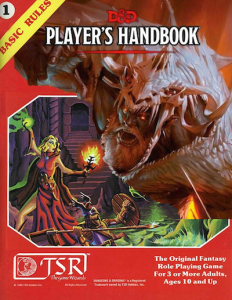Is this not just the new Basic D&D? Not quite.
(If you like this mashup, here’s a one page PDF version.)
 Ability scores: 3d6 down the line. Rearrange as desired. Bonuses from B/X (page B7), because the bell curve distribution of +1, +2, +3, with max 18, makes bonuses more special than the 5E linear increase. Ability checks: roll 1d20 <= score (lower better). Skill checks: roll 1d20 +bonus & +proficiency if proficient (higher better; vs. DC 10 most of the time).
Ability scores: 3d6 down the line. Rearrange as desired. Bonuses from B/X (page B7), because the bell curve distribution of +1, +2, +3, with max 18, makes bonuses more special than the 5E linear increase. Ability checks: roll 1d20 <= score (lower better). Skill checks: roll 1d20 +bonus & +proficiency if proficient (higher better; vs. DC 10 most of the time).
Recovery and dying: re-roll HP during each downtime. Save or die when reduced to zero HP.
Classes are the fighter (HD d8), magic-user (HD d4), and thief (HD d6) from B/X but interpreted as makes most sense in light of the below referenced 5E rules. Use fighter XP progression for all classes (page X6).
Turn undead is a first level spell; use B/X rules (page X5). Successful turns, or turn results that are doubles, do not expend the spell. Concentration required. If you want to play a demon hunter or cleric, make a fighter and take the turn undead spell as your first level feat. (Necromancers: substitute command undead.)
Fighters begin with proficiency in all weapons and medium armor. (Yes, medium. If you want to use heavy armor without penalty, you need to spend a feat.)
Magic-users begin with proficiency in daggers and no armor. Spell progression is from B/X (page X6). Roll three starting spells randomly from B/X or some other spell list. You can pick a spell too if that’s what you spend your first feat on. Spell casting in armor without proficiency is impossible.
Thieves begin with proficiency in club, dagger, staff, short sword, sword, short bow, light crossbow and light armor. They also start with proficiency in dexterity (stealth), strength (climb), intelligence (search), backstab (or sniper), and thieves’ tools.
Backstab is only for surprise melee attacks and deals +1d6 damage per point of proficiency. (But see also the sniper feat.) Distraction + successful stealth check = hidden. Attack from hiding = surprise.
Situational modifiers: Use 5E advantage and disadvantage.
Armor: Ascending AC and armors from 5E (PHB page 145). If you do not meet the heavy armor strength requirements, you take disadvantage on most physical tasks (rather than the speed modifier suggested by the 5E rules, because that does not really come into play unless you are counting squares). Shields: proficiency with medium armor grants the ability to use shields passively. Otherwise, a shield is just a weapon and you need to spend an action to get any defensive benefit.
Weapons: From B/X (damage on page B27). Attack bonus: apply your proficiency bonus to attacks with weapons for which you have proficiency. Finesse weapons: (dagger, stiletto, rapier, etc) use the dex bonus rather than the strength bonus for attack and damage. Initiative: group d6, highest wins.
Feats: Characters gain a feat at levels 1, 4, 7, 10, & 13. Yes, first level too. So go crazy with a spell-casting fighter or a swording magic-user. Who needs multi-classing? Or just go fighter/cleave. Choose from the following options whenever you get a feat. (Or roll if feeling oracular.)
- +1 to the ability score of your choice (max 18)
- Never surprised
- +2 HP
- Cleave (taking down an enemy in melee grants a free adjacent attack)
- Spell and bonus spell slot
- Backstab or sniper (ranged backstab) +1d6 damage
- Armor proficiency increases one step (none, light, medium, heavy)
- Weapon proficiency (or specialization: +1 damage with a particular weapon)
- Skill proficiency (5E PHB page 174)
- Tool proficiency (5E PHB page 154)
Bonus spell slots can be used to prepare spells of first level or any level that you can otherwise cast.
References: B/X (Basic/Expert) rules & the 5E PHB
